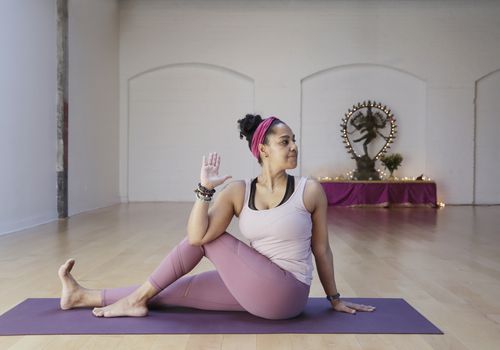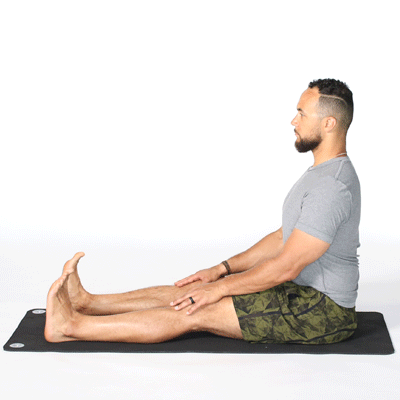
You can strengthen your legs with the yoga leg pose. Start by lying down on your mat, with your feet slightly bent. Lift your left leg upwards and bring it under your left thigh. Bend your right leg up towards your chest and bring it under your left forearm. Next, use your left hand to grab your right knee and attach it to the mat. Next, grab the inside of your right knee with your left hand and nail it to the mat. You should bend your left leg toward your chest.
The second yoga pose for legs is legs up-the-wall. This position is believed to reduce blood pressure and stress. To perform this yoga pose, lower your back to the floor and wiggle your legs closer to the wall. Your head should rest on the floor. Continue holding the pose for at least a few minutes, until the sensation stops. After you feel the tingling stop, return to your original pose. These poses are great to strengthen your hamstrings and thighs.

You can also perform the legs-up-the-wall pose for a variety of reasons. It improves digestion and also strengthens the arteriovenous network. It also helps to keep your body light-weight and flexible by pumping blood toward your legs and hips. It is also useful for menstrual issues. It is also beneficial for aging. This yoga leg position can be done by finding an open area near a brick wall. You will then need to adjust your body accordingly. If necessary, you might want to cover your back with a blanket.
The adductor stretch stretches the inner thighs. Begin by bending down your left knee. Then, lift your butt up. Continue this exercise for approximately 30 seconds. Then, switch sides. Your main goal with this yoga leg stretch, is to stretch your inner legs. Using deep breaths, you can even bring your head down to the floor. For a more complete experience, you can also hold the position for a few moments to get a better understanding.
Yoga leg stretch can reduce lower leg swelling and also provide therapeutic benefits for your lower back, feet, and lower back. It is a great way to recover from a workout and relax your legs. These yoga poses are not only beneficial for the body, but also have other benefits. They are good for anxiety, premenstrual syndrome, and fatigue. These exercises can be used to relieve a variety of symptoms. Yoga is a great way to increase flexibility in your legs.

A popular way to strengthen your legs and reduce stress is yoga leg stretch. To tone the lower body, yoga leg stretch is a great way to tone it. To improve your flexibility, try doing the pose on a wall. You will notice a difference once you begin this stretch. Your legs will look more toned in no time. You can also improve your circulation with this method. You'll also look better overall if you have a strong lower body.
FAQ
What's the Best Way to Lose Weight?
Losing weight can be difficult. Many people give up easily because they don't know what to do.
However, there are some simple steps that you can take to shed those extra pounds.
First, ensure that you consume fewer calories per day than you burn. If you consume more calories than what you burn, you will gain weight.
Second, you must start exercising regularly to burn off all those calories. You can choose from a variety of exercises such as walking, biking or dancing.
Third, you must stop smoking cigarettes and drinking alcohol. These habits cause you to consume more calories than you would otherwise.
Fourth, cut down on junk food and fatty foods. These can be replaced with healthier options like fruits, vegetables and whole grains.
Fifth, it is important to make lifestyle changes and develop new habits. For example, you may need to get up early every morning to exercise before work.
Sixth, be disciplined and stick to your diet plan.
For those extra calories, you could join a class or go to a gym.
You will quickly notice the difference by following these simple tips.
What is butter good for?
Butter is one of the best sources of saturated fats. This fat is good for hair and skin health, as well as stronger bones.
Vitamin K is also found in butter, which helps prevent bleeding from cuts or bruises. Vitamin K is combined with vitamin C to prevent bruises.
Butter is also rich with minerals, such as calcium and phosphorous. These elements promote stronger bones and teeth.
Butter is not without its flaws. Butter is high in cholesterol. A few studies have shown that too much cholesterol can increase the risk of developing coronary disease.
Butter is also high-fat, which can contribute to obesity and increase cholesterol.
But if butter is a must, you can spread it on bread and not dip it in soups or salads. Bread absorbs less oil than pasta and potatoes.
How To Build Muscles Fast?
It is important to eat healthy food and lift weights frequently in order to quickly build muscle.
Early morning is the best time to exercise. You are awake and alert, ready to take on the day.
Exercises such as push-ups and bench presses are good options.
Consider trying different weight training programs and drinking plenty of water throughout each day.
Statistics
- The PRS enabled risk stratification for overall prostate cancer and lethal disease with a four-fold difference between men in the highest and lowest quartiles (HR, 4.32; 95% confidence interval [CI], 3.16-5.89). (pubmed.ncbi.nlm.nih.gov)
- According to the American Heart Association, blood pressure should be checked at least once every two years, beginning at age 20. (my.clevelandclinic.org)
- Cardmembers earn 5% Back at Amazon.com with a Prime Credit Card. (amazon.com)
- Are You One of the 20% of Guys (mh.co.za)
- By John Thompson Take a whopping 38% off a set of PowerBlock Pros. (menshealth.com)
External Links
How To
How can a man get in shape in 30 days?
Breaking down your fitness goals into smaller, more manageable steps is the best way for you to reach your fitness goals.
You need to make sure you are working towards the goal each day. This could include anything from 10 pushups that last 5 minutes to running 3km.
Positive results will be achieved if you do this consistently over time.
Here, consistency is the key. Keep at it until success!
What is the difference between Aerobic Fitness and Anaerobic Fitness?
Anaerobic fitness refers the body's ability to do intense physical work while lacking oxygen. During periods of high-intensity exercise, we use anaerobic pathways to provide enough energy to complete the task. Anaerobic pathways are glycolysis, creatinephosphate and the phosphagen.
Contrary to that, aerobic fitness is the ability to sustain low-intensity exercises for a long time. Aerobic exercise is a form of aerobic exercise in which oxygen is the primary fuel source for the cells. The aerobic pathway is more efficient than the anaerobic.
For example, if you want to run a marathon, you must first build up your aerobic capacity. If you don't focus on increasing your aerobic capacity, you will not be able finish the race.
Aerobic fitness is also referred to as cardiovascular fitness. The two most common methods of measuring cardiovascular fitness are VO2 max testing and step tests.
Test VO2 Max
The body's maximum oxygen consumption during exercise is called the VO2 Max. This test measures the amount O2 that the body can use when exercising.
This is one of the most accurate tests to measure cardiovascular fitness. However, it requires expensive equipment and highly trained professionals to administer the test.
Step Tests
Step tests are a quick and easy way to test your cardiovascular fitness. They involve walking or jogging on a treadmill or track for a certain duration based on your age and weight.
These tests are simple to perform, cost-effective, and easily accessible from almost any location. For instance, you can walk on a treadmill for 2 minutes, rest for 1 minute, repeat this process for 20 minutes, and then stop. Throughout the session your heart rate should not exceed a specified range.
This is the "Bruce Protocol". Bruce was himself a runner and developed the protocol after realizing his heart rate wouldn't increase when he ran for longer distances.